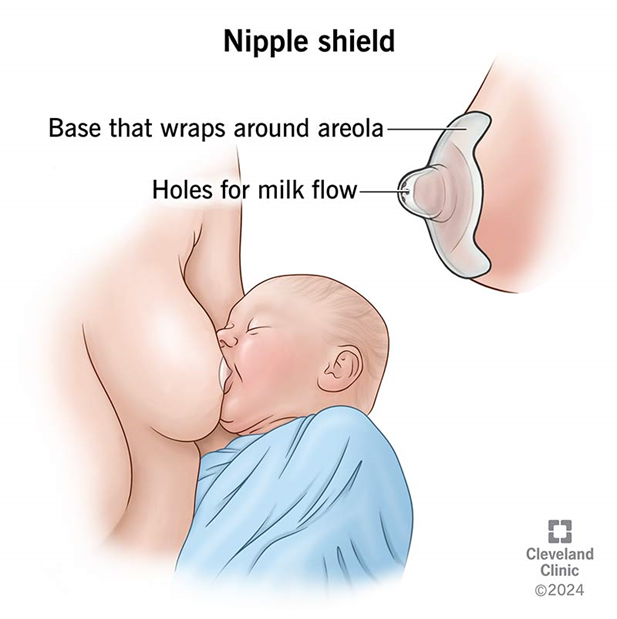A client who is one day postpartum reports to the nurse that her baby cannot latch onto the breast. The nurse observes that the client's nipples are inverted. Which action should the nurse implement?
Offer supplemental formula feedings.
Teach about the use of a breast pump.
Recommend using a breast shield.
Encourage the use of ice on the areola.
The Correct Answer is C
The correct answer is c. Recommend using a breast shield.
Choice A reason: Offering supplemental formula feedings is not the first-line action for inverted nipples as it does not address the issue and may lead to nipple confusion, potentially complicating future breastfeeding attempts.
Choice B reason: Teaching about the use of a breast pump is beneficial for milk expression but does not directly assist with the immediate concern of latching issues due to inverted nipples.
Choice C reason: Using a breast shield can be helpful for mothers with inverted nipples. It can temporarily draw out the nipple, allowing the baby to latch on more easily. This tool acts as a bridge between the breast and the baby's mouth, facilitating breastfeeding while the mother works on long-term solutions for her inverted nipples.
Choice D reason: Encouraging the use of ice on the areola may temporarily stiffen the nipple, but it is not a recommended practice for addressing inverted nipples as it can cause discomfort and may not be effective in promoting a successful latch.

Nursing Test Bank
Naxlex Comprehensive Predictor Exams
Related Questions
Correct Answer is ["1"]
Explanation
This is the correct answer because the concentration of cefazolin after reconstitution is 1 gram/2.5 mL, which is equivalent to 400 mg/1 mL. Therefore, to administer 400 mg of cefazolin, the PN should draw up 1 mL of the reconstituted solution. This can be calculated using the formula:
Desired dose / Available dose = Volume to administer
400 mg / 1000 mg = x mL / 2.5 mL
x = (400 x 2.5) / 1000
x = 1 mL

Correct Answer is C
Explanation
Choice A rationale:
Discuss the character of labor from endogenous vs. exogenous oxytocin. While it is important to educate the client about the difference between endogenous (naturally occurring) and exogenous (administered) oxytocin, this information may not address the client's primary concern. The client is refusing the prescribed oxytocin infusion and wants a "natural" delivery. Therefore, discussing alternative ways to support her birth plan is more pertinent.
Choice B rationale:
Ask the healthcare provider to discuss the issue with the client. Involving the healthcare provider in the discussion is a reasonable step, but it should not be the first action taken. The nurse can initiate a conversation with the client to explore her concerns and preferences before escalating the issue to the healthcare provider.
Choice C rationale:
Discuss alternative ways to support the client's birth plan. This is the correct choice because it directly addresses the client's refusal of the oxytocin infusion and desire for a "natural" delivery. Exploring alternative methods for inducing or facilitating labor in a way that aligns with the client's birth plan is essential.
Choice D rationale:
Explain the indications for induction related to post-term pregnancy. Explaining the indications for induction is important for educating the client about the medical reasons behind the prescribed treatment. However, this information may not immediately address the client's refusal of the oxytocin infusion. The nurse should first explore the client's concerns and preferences regarding her birth plan.
Whether you are a student looking to ace your exams or a practicing nurse seeking to enhance your expertise , our nursing education contents will empower you with the confidence and competence to make a difference in the lives of patients and become a respected leader in the healthcare field.
Visit Naxlex, invest in your future and unlock endless possibilities with our unparalleled nursing education contents today
Report Wrong Answer on the Current Question
Do you disagree with the answer? If yes, what is your expected answer? Explain.
Kindly be descriptive with the issue you are facing.
